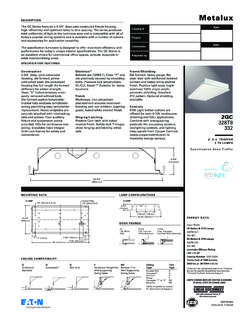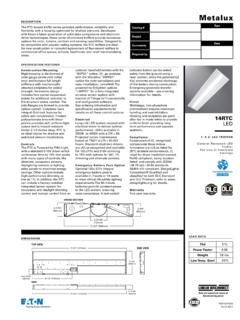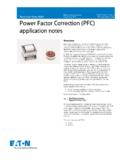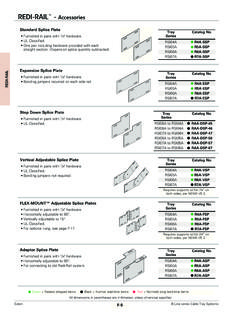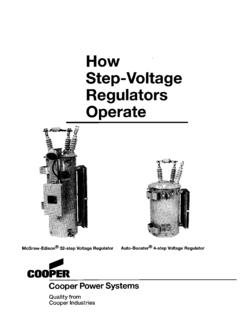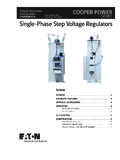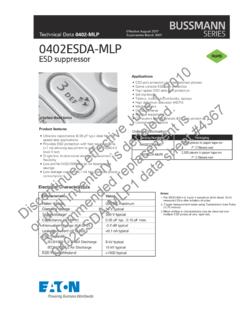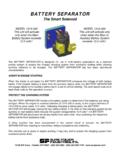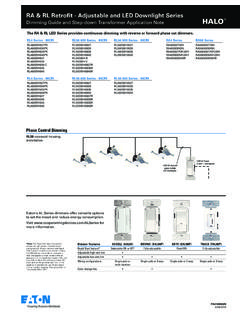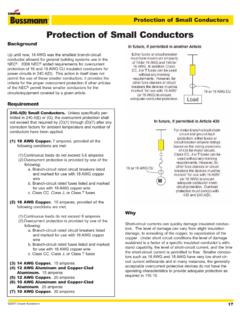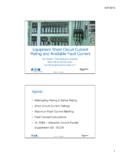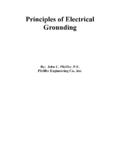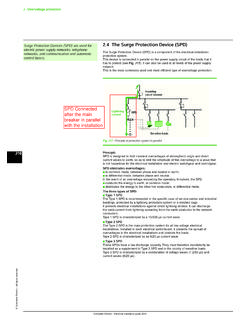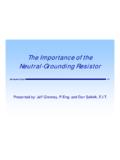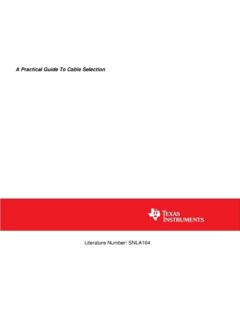Transcription of CONDUCTOR SHORT-CIRCUIT PROTECTION Introduction
1 CONDUCTOR SHORT-CIRCUIT PROTECTION 2000 Cooper Bussmann, Inc. Page 1 of 1012/17/01 Introduction :This paper analyzes the PROTECTION of wire from fault currents. It gives the specifier thenecessary information regarding the SHORT-CIRCUIT current rating of wire. Proper PROTECTION of wire willimprove reliability and reduce the possibility of injury. Wire can be destroyed if the overcurrentdevices do not limit the SHORT-CIRCUIT current to within the SHORT-CIRCUIT current rating of the matching the ampere rating of the wire with the ampere rating of a protective device will notassure component PROTECTION of the wire under SHORT-CIRCUIT the past several years, there have been numerous reports in newspapers, magazines andinsurance company files about destroyed electrical systems.
2 Recognizing this as a serious problem tosafety of life and property, much more emphasis has been placed on COMPLIANCE with THE 2002 NATIONAL ELECTRICAL CODE (NEC) .The NEC covers COMPONENT PROTECTION in several sections. The first section to note isSection PROTECTION and the NEC:Per NEC circuit Impedance and Other Characteristics:"The overcurrent protective devices, the total impedance, the component SHORT-CIRCUIT currentratings, and other characteristics of the circuit to be protected shall be selected and coordinated aspermit the circuit -protective devices used to clear a fault to do so without extensive damage to theelectrical components of the circuit .
3 This fault shall be assumed to be either between two or more of thecircuit conductors, or between any circuit CONDUCTOR and the grounding CONDUCTOR or enclosing metalraceway. Listed products applied in accordance with their listing shall be considered to meet therequirements of this section."This requires that overcurrent protective devices, such as fuses and circuit breakers be selectedin such a manner that the SHORT-CIRCUIT current ratings of the system components will not be exceededshould a SHORT-CIRCUIT SHORT-CIRCUIT current rating is the maximum SHORT-CIRCUIT current that a component canwithstand.
4 Failure to provide adequate PROTECTION may result in component destruction under SHORT-CIRCUIT first step to verifying CONDUCTOR SHORT-CIRCUIT PROTECTION is to calculate the short -circuitcurrent fault levels throughout the electrical system. The next step is to check the SHORT-CIRCUIT currentrating of wire and cable, based upon the calculated SHORT-CIRCUIT fault current available and theovercurrent protective device : The let-through of the protective device must be equal to or less than the SHORT-CIRCUIT currentrating of the component being : Choosing overcurrent protective devices strictly on the basis of voltage, current, andinterrupting rating alone will not assure component PROTECTION from SHORT-CIRCUIT currents.
5 Highinterrupting capacity electromechanical overcurrent protective devices, especially those that are notcurrent-limiting, may not be capable of protecting wire, cable or other components within high SHORT-CIRCUIT ranges. The interrupting rating of a protective device pertains only to that device and hasabsolutely no bearing on its ability to protect connected down-stream components. Quite often, animproperly protected component is completely destroyed under SHORT-CIRCUIT conditions while theprotective device is opening the faulted circuit without damage to itself. 2000 Cooper Bussmann, Inc.
6 Page 2 of 1012/17/01 CONDUCTOR SIZE: SHORT-CIRCUIT Currents for InsulatedCablesThe recent increase in KVAcapacity of power distribution systems hasresulted in possible SHORT-CIRCUIT currents ofextremely high magnitude. Fault induced,high CONDUCTOR temperatures may seriouslydamage CONDUCTOR a guide in preventing suchserious damage, maximum allowable SHORT-CIRCUIT temperatures, which begin to damagethe insulation, have been established forvarious insulation such as, Thermoplastic at150 Insulated Cable EngineersAssociation (ICEA) PROTECTION chart, to theright, shows the currents, which, afterflowing for the times indicated, willproduce these maximum temperatures foreach CONDUCTOR size.
7 The system SHORT-CIRCUIT capacity, the CONDUCTOR cross-sectional area and the overcurrent protectivedevice opening time should be such thatthese maximum allowable short -circuitcurrents are not the formula shown on theICEA PROTECTION chart will allow theengineer to calculate SHORT-CIRCUIT currentratings of cable not shown on these pages. Itmay be advantageous to calculate SHORT-CIRCUIT current ratings below one cycle, when the opening time of the current-limiting deviceis Equipment Grounding Conductors:Safety issues arise when the analysis of equipment grounding conductors is discussed.
8 Of the NEC offers minimum sizing for equipment grounding problem of protecting equipment grounding conductors was recognized more than 30 yearsago when Eustace Soares, wrote his famous grounding book Grounding Electrical DistributionSystems for Safety . In his book he states that the validity rating corresponds to the amount of energyrequired to cause the copper to become loose under a lug after the CONDUCTOR has had a chance to coolback down. This validity rating is based upon raising the copper temperature from 75 C to 250 addition to this and the ICEA charts, a third method promoted by Onderdonk allows thecalculation of the energy necessary to cause the CONDUCTOR to melt (if the copper CONDUCTOR reaches atemperature 1,083 C).
9 Table 1 offers a summary of these values associated with various size copperconductors. 2000 Cooper Bussmann, Inc. Page 3 of 1012/17/01It becomes obvious that the word Minimum in the heading of table means just that -the values in the table are a minimum - they may have to be increased due to the available short -circuitcurrent and the current-limiting, or non-current-limiting ability of the overcurrent protective engineering practice requires the calculation of the available SHORT-CIRCUIT currents (3-phase and phase-to-ground values) wherever equipment grounding conductors are used.
10 Overcurrentprotective device (fuse or circuit breaker) manufacturers literature must be consulted. Let-throughenergies for these devices should be compared with the SHORT-CIRCUIT current rating of the equipmentgrounding conductors. Wherever let-through energies exceed the minimum equipment groundingconductor SHORT-CIRCUIT current ratings, the equipment grounding CONDUCTOR size must be increased untilthe SHORT-CIRCUIT current ratings are not 1: Comparison of 75 C CONDUCTOR 5 Second Current and I2t Ratings (Based on RMS Amperes)5 Second Rating (Amps)I2t Rating (Amperes Squared Seconds)CondSizeCondAreaCirc.
